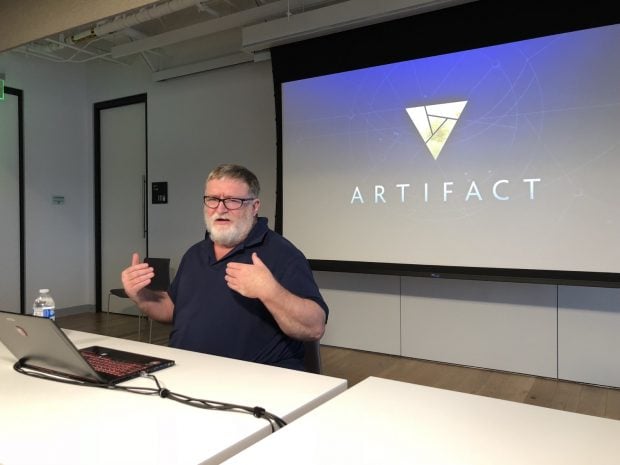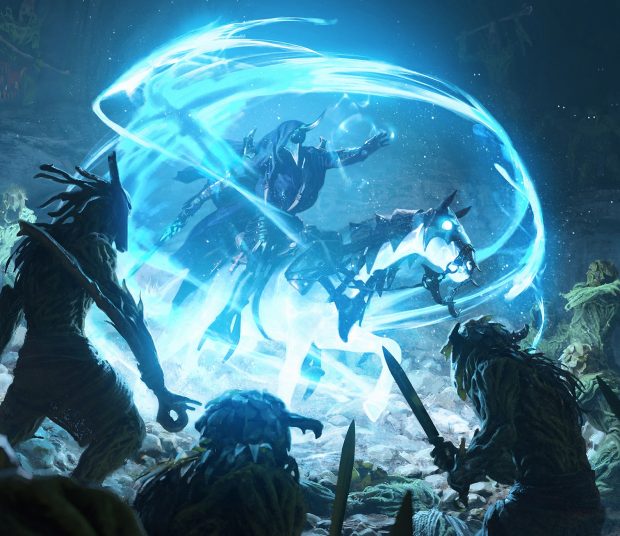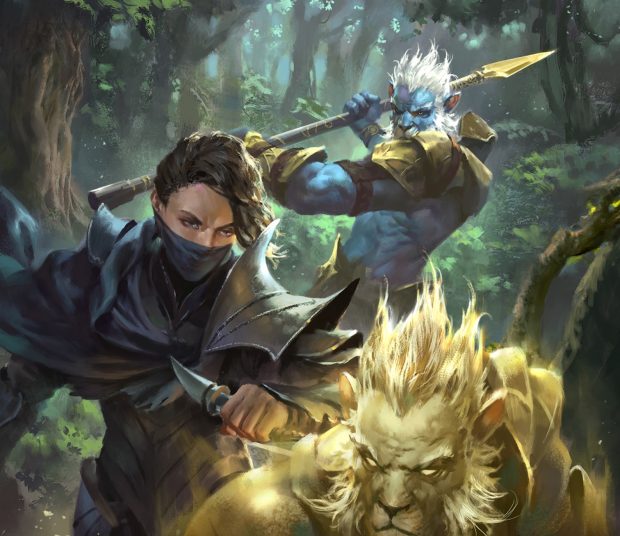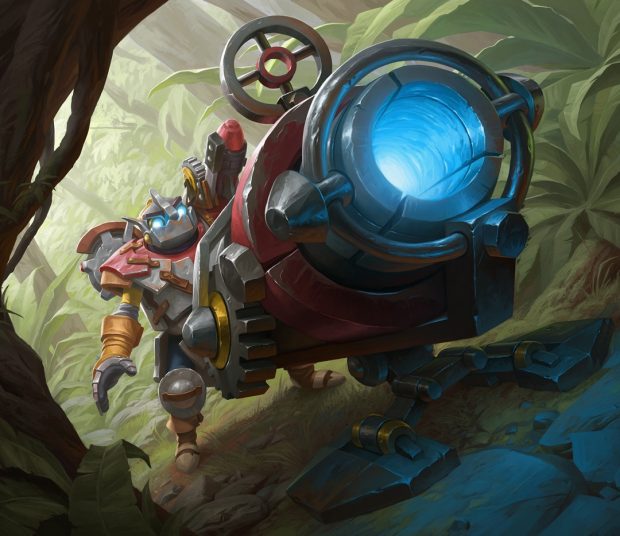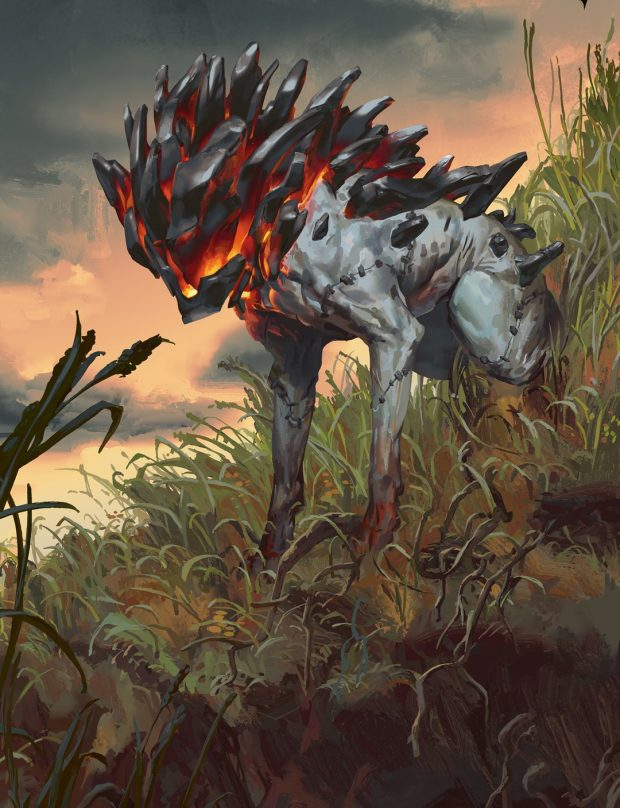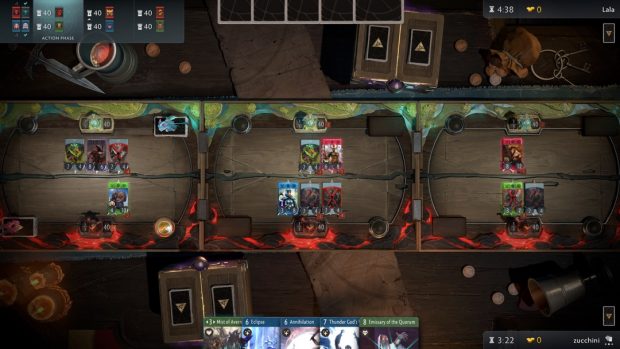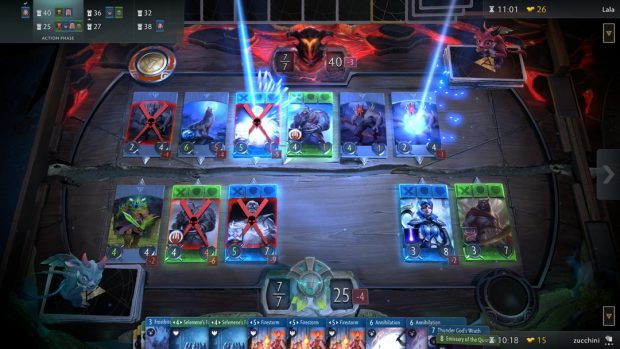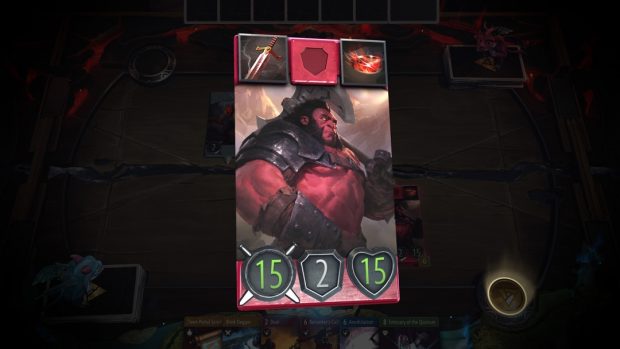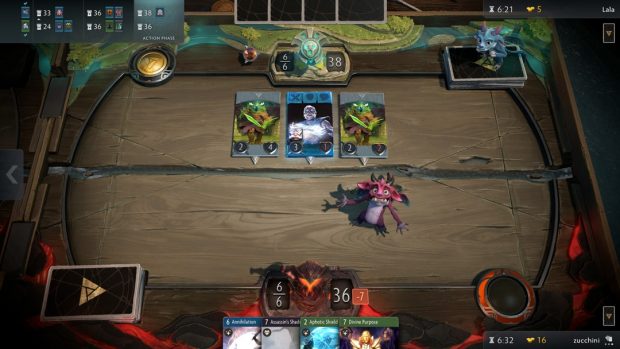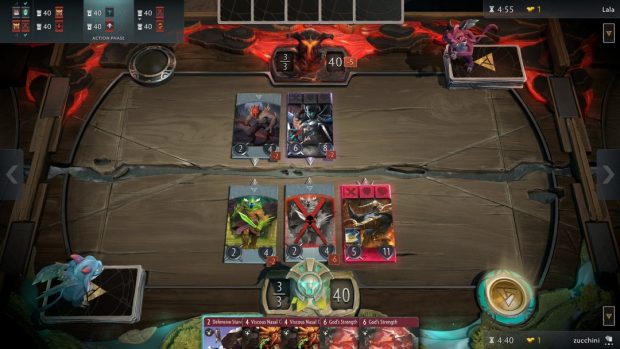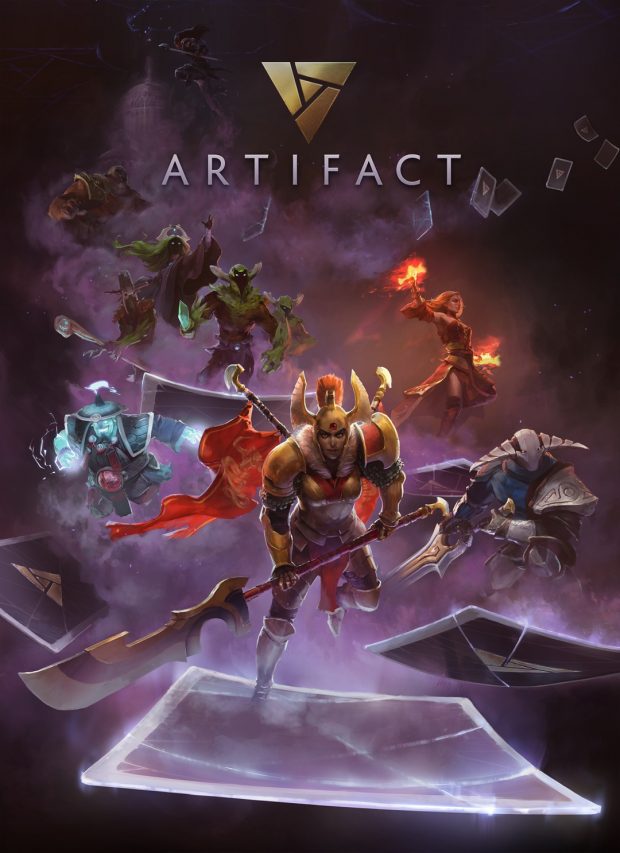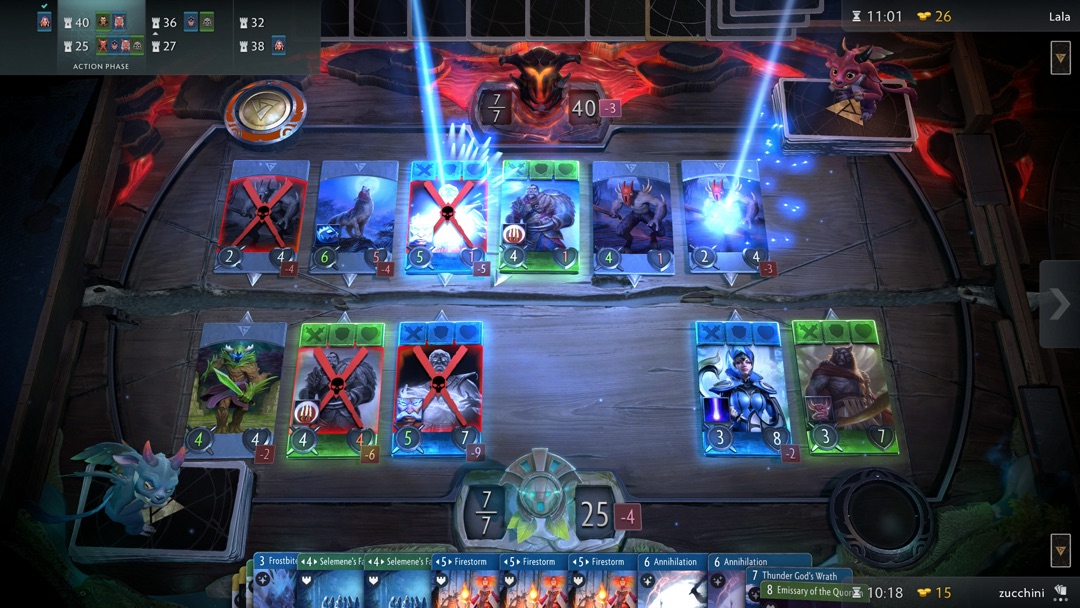Valve didn’t bring me to Washington just to give me a tour of their super cool offices, they also happened to finally blow the lid off of Artifact, the card game they teased last year. While it’s no Half-Life 3, I really doubt many people will be disappointed once they give the game a try. Artifact is a digital collectable card game that is designed by Richard Garfield, the creator of Magic: The Gathering, with a hefty amount of Valve’s own special sauce slathered on top. If you’re unfamiliar with Valve stuff, the most succinct way to describe their approach to things is half-assing nothing. It might take forever for them to do something, but when they do it, it’s executed on a level that’s borderline flawless- This certainly seems to be the case with Artifact.
To kick things off, Valve’s Gabe Newell (who honestly is just on a first name basis with the entirety of the internet, it seems like) gave us a brief presentation on the history of Valve and how it informs the direction of Artifact. First off, Gabe stressed that at Valve, games aren’t about making money, they’re about solving a problem. Half-Life was created to prove that they could make games, its sequel identified several key innovations to move the first person shooter genre forward. Following the massive expanse between the launch of the two games, Valve shifted to releasing episodic content for HL2 to try to feel closer to customers.
When they wanted to tackle co-op, Left 4 Dead was the perfect way to do it. They then felt like, in the words of Gabe, making something “entirely novel," and that’s where Portal came from. Similarly, Dota 2 exists as an original experiment to build a community economy. It’s at this point in Valve’s history that they thought the PC gaming history was heading in a bad direction, as the iPhone was distracting loads of people with its closed ecosystem which was worrisome to Valve- Particularly as VR platforms started following in the similarly locked down footsteps of Apple.
The reaction to this was SteamVR and the HTC Vive, along with spooling up an entire hardware division. Valve can now build software and hardware simultaneously, and Gabe mentioned that they’re “jealous" of what Nintendo has done with the Switch and its incredible marriage of fantastic software and hardware. They plan on taking advantage of this capability in the future, but Gabe left what that could possibly entail as a open-ended mystery.
Anyway, the problem with building up this whole hardware division and creating a new VR platform is these sorts of things don’t result in games. Now, Valve is going to start making games again, and the first title released in this new initiative is going to be Artifact. Gabe described it as, “Artifact is to trading card games as to what Half-Life 2 was to single player games."
Artifact itself is a very, very deep game and every development decision made on the game was to make it as deep as possible. Like Dota 2, Artifact is a game that cannot be “solved," and it was built from the ground up to ensure all the choices you make in game are interesting. They’re planning on incorporating all the best lessons they learned from their activities in esports as well, which means pretty big things when you look at how huge the Dota 2 International is.
During his presentation, Gabe continually reiterated that Artifact is not free to play and not pay to win. Card rarity does not correlate to card power, and many design decisions when building the game were made with the complete intent to steer away from pay to win whenever possible. That being said, you will be able to buy booster packs and all of the cards will be tradable on the Steam Marketplace, so I’m super fascinated to see how that all shakes out.
If you’ve never played a Steam game with items, basically the way it works is you have a massive inventory of things from inside of games that you can trade, sell to, or buy from other players. This creates a player-run economy where items have real value, and sometimes, extreme value. For instance, I have a bandanna my character in Playerunknown’s Battlegrounds can wear. As of this writing, I could sell that one cosmetic item for around $600, and it peaked as high as $1,000. Valve and Bluehole (the PUBG developer) had nothing to do with setting that value, that’s just what players decided it was worth.
This is going to be huge for Artifact. Most other popular digital collectable card games effectively lock your purchases into the game. If I want to sell my Hearthstone cards, I’m out of luck unless I want to venture into the ban-worthy waters of just selling my entire Blizzard account which is also linked to all my other Blizzard games. If I get tired of Artifact, I can just sell all my cards for Steam credit. (Although actually getting cash from Steam credit is a ton more weird hoops to jump through, but it is possible.) Gabe even mentioned how strange it is that physical card games have substantially greater liquidity than digital card games, which I’ve experienced first hand as a Magic player.
In paper games, there’s very little barrier between switching decks. If I get tired of what I’m playing, I can either sell or trade my cards to reasonably easily get the next deck I want. Compare this to grinding to build a deck in a digital CCG, not liking it, and then just blowing it up to get whatever crafting material the game uses to create cards. In that situation, I lose an incredible amount of value. Additionally, this is super discouraging to players looking to try new decks, and potentially even leads to stagnation in the meta as people are so invested in the decks they have.
It was continually reiterated that cards in Artifact need to hold their value for this whole thing to work, which is another reason why the game will not be free to play. The thought process there is that anything that has a value of zero, whether that’s the player’s time that is put into game, the accounts themselves, or even the cards, the relative value of everything else in that ecosystem eventually also goes to nothing. When I pressed on the specifics of this and how players will pay for the game if it isn’t free to play, there weren’t any solid details to be found yet.
If I had to use my gut and guess, based on everything that was laid out it wouldn’t surprise me if the game has an up-front cost (like Counter-Strike: Global Offensive which costs $15) that likely will include a base set of cards. From there, packs will cost money, making every card in the ecosystem worth something. How it all shakes out when it launches, however, is anyone’s guess.
As far as the actual game is concerned, the way Gabe put it is that Artifact is the best card game that Valve can build, and it just so happens to use the Dota 2 IP because it made the most sense. They’ve focused on building novel mechanics that aren’t in other card games, which definitely seemed to be the case when I played it.
Now, before I get into what playing Artifact is actually like, I should explain how the preview opportunity went. Gabe gave his presentation on the game, then we shifted over to gaming PC’s running it. I had the opportunity to play two games, each with a different decks. The games went fast, and I was paired up with a member of the Artifact team who explained to me how to play.
It’s a super complicated game, and we weren’t allowed to capture any of the gameplay, so all of these mechanics are based on a brain dump I did by typing as much into my phone as possible after the demo. Please treat this as a general overview instead of getting hung up on any specifics, as it’s entirely possible I interpreted things wrong or otherwise misremembered.
With that out of the way, the first thing you notice about Artifact is there’s not one, but three game boards (or “lanes," since this is based on Dota 2). Initially this is unbelievably overwhelming, as each lane has its own board state complete with cards that provide passive abilities like a constant two damage to enemies at the start of your turn and other things like that. It starts to make a lot more sense when you stop thinking of it in the traditional card game sense, and instead look at it as an unbelievably clever card-based interpretation of a MOBA.
Decks consist of five hero cards and 40 other cards that you can customize as you see fit. The first interesting wrinkle in deck building is that the five heroes you’re running are displayed on the game’s loading screen and each hero comes with their own cards that get inserted into your deck. So, if you see I have a particular hero, you also know that I have specific cards that hero comes with. The rest are a mystery.
The game begins with three of your five heroes randomly spread out across each of the three lanes. The game moves from the left-most lane to the far right lane. On your first turn, in the left lane, you’ll begin with three mana. Using that mana, you can cast any spell card in your hand that corresponds with the color of the hero (I was exposed to red, black, green, and blue heroes while playing) that is currently active in that lane, or any neutral cards you might have such as equipment or special types of neutral minions.
With each card you cast, priority is passed to the opposite player. With three mana, you won’t be doing much on the first turn, but with each additional turn of the game you’ll gain one more mana, so like Hearthstone and other CCG’s, things quickly ramp up to where you’re playing super powerful, high cost cards. Once both players have hit a point where they have no more spells left to play, they’ve passed priority to the other player, and they also had nothing to play, battle commences.
Positioning of your cards is super important, as when the battle phase occurs, each card “fights" the card across from it. Any heroes or minions that don’t have a card opposing them directly attack your “tower" which you can think of as the vague equivalent of “going for face" in Hearthstone or attacking a player directly. The tower in each lane has 40 HP, and once a tower is destroyed it respawns as a nexus and has 80 HP. The first player to either destroy two towers, or destroy the tower and nexus in one lane wins.
Once the battle phase is over, chances are your heroes will be low on health and your minions might be dead… But there’s no time to worry about that right now as the game then shifts focus to the middle lane, where you go through the same motions, eventually have a battle phase, and then shift to the final far right lane where this repeats again. At the beginning of the next turn, you’ll get two more heroes and you’ll need to decide which lanes to dispatch them to.
There’s a absurd amount of weight to this decision, as you don’t know where your opponent will be dispatching their own heroes and it’s important that you have the right colored heroes in the ideal lanes. You could run into a situation where you have a blue spell card that would be perfect to use to turn the tide of battle in one lane, but if you don’t have a blue hero active in that lane you can’t cast it.
Also, each turn minions spawn in your lanes (just like a MOBA) but there’s an additional layer of strategy as they’re allocated randomly. You need to position your heroes without knowing where you might or might not have minions. Any area of the board that doesn’t have a minion or a hero will have a “lane" card dropped in it. Most are straight across so cards just do damage directly to the card across from it, but if they’re curved your cards “curve" into the card the lane points at instead of going directly to the tower.
This is where you’ll also encounter the equipment shop for the first time. As you kill minions and enemy heroes you’re awarded gold, much like killing units in a MOBA. Using this gold, you can buy items which are either things like equipment to buff your heroes or potions to heal them. Like the escalating mana cost of cards, equipment also varies wildly in price with things like a +1 sword which gives a hero +1 attack only costing a few gold while super powerful items might require saving up for several turns.
Equipment is played like any neutral card, and uses mana but then buffs up the specific hero card you played it on for the entire game. If at any time one of your heroes dies (and they will), they “go back to the fountain" for one whole turn, and then can be redeployed the following turn after that. So, if I lost two heroes in one turn, I’ll be down those two heroes the next turn, then get to re-reploy them the turn after that. At that point, I’ll also be able to put them in different lanes if I feel like it.
Crazier yet, there is no limit to the amount of units that can be in any particular lane or the size of your hand. Normally I’d say this sounds sort of broken, but if the entire game is built around that I can only imagine the shenanigans that’ll eventually take place once we’re playing the game. One of the games I played I had a stupid amount of cards in my hand, and they just kept scrolling.
Inside of this framework, the potential for depth is just unbelievable- Particularly with equipment like the Blink Dagger which allows a hero that has it equipped to rapidly shift lanes, and spell cards which can target other lanes. The strategic options are seemingly unlimited, as you could just rush down one lane twice, but in the process you might give up other lanes dedicating so many resources, and so on. There’s so much more to it too, this is the longest preview I’ve ever written for a mobile game and I feel like I’ve barely scratched the surface of the brain explosion Valve offered us on Artifact. Hopefully you guys can see the level of depth soon, as Artifact will be released on PC this year, with a mobile version coming in 2019.
If anyone has any additional questions on the game, I’ll try my best to answer them in the comments.
